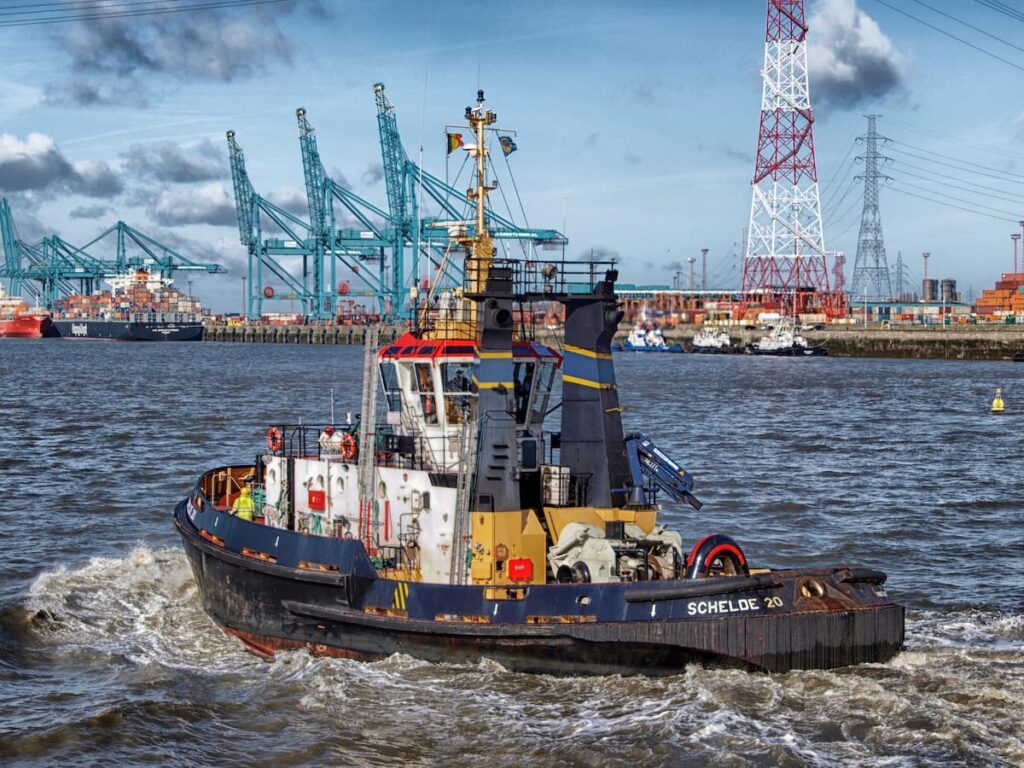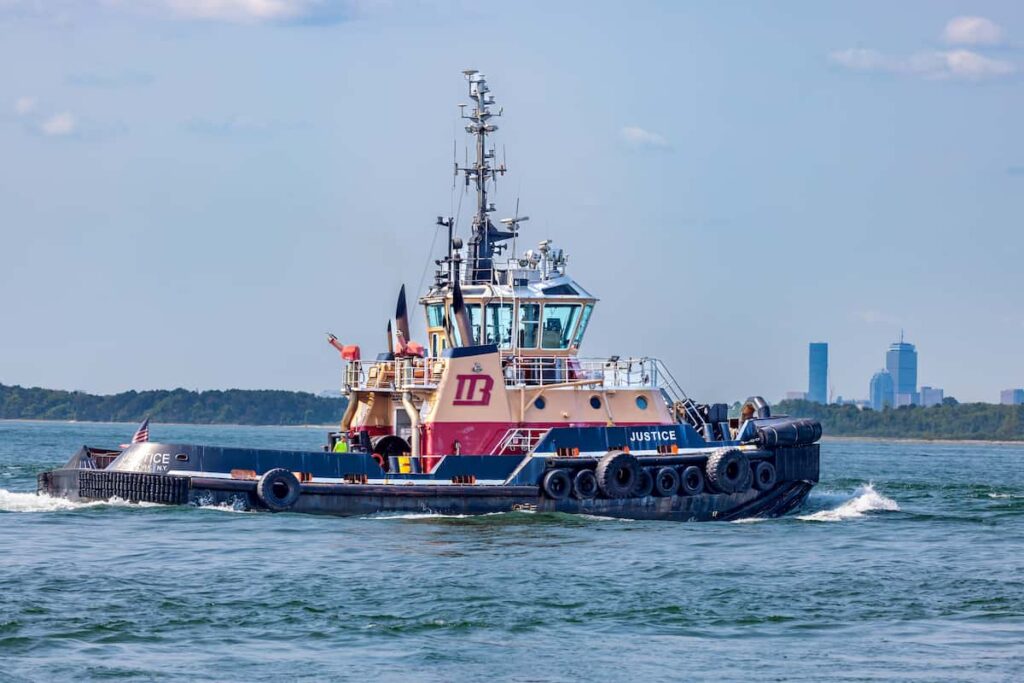Tugboats are some of the most powerful vessels on the water. They are designed to move massive objects, such as large ships and barges, and are capable of pulling weights that are many times their own. Tugboats are used in ports and harbors all over the world to help move cargo and other vessels. But how can tugboats pull so much weight?
The answer to the question of how tugboats can pull so much weight lies in their engines and design. Tugboats are built with powerful engines that generate a lot of torque, which is the twisting force that is needed to move heavy objects. These engines are typically diesel-powered and can produce a significant amount of horsepower. Additionally, tugboats are designed with a heavy, sturdy hull that allows them to withstand the strain and stress of towing large objects.

Despite their small size, tugboats are incredibly effective at moving large objects. They are able to maneuver in tight spaces and are often used to guide ships into and out of ports. Tugboats are also equipped with powerful winches and towing lines, which allow them to secure and move heavy objects safely and efficiently. Overall, tugboats are an essential part of the maritime industry and play a critical role in moving goods and cargo around the world.
The Basics of Tugboats
What is a Tugboat?
Tugboats are small, powerful boats that are designed to move large vessels around in tight spaces. They are often used in ports and harbors to help ships maneuver in and out of docks and to help them navigate through narrow channels and waterways. Tugboats are also used to tow barges and other vessels along rivers and canals.
Tugboats are typically equipped with powerful engines and heavy-duty towing equipment, including winches and towing cables. They are designed to be highly maneuverable, with a short, wide hull and a flat bottom that allows them to turn quickly and navigate in shallow waters.
Tugboat Design
Tugboats come in a variety of shapes and sizes, depending on their intended use. In general, however, they are designed to be highly maneuverable and capable of generating a lot of pulling power.
Most tugboats have two diesel-powered engines that run the propellers. These engines are designed to provide a lot of torque, which allows the tugboat to generate a lot of pulling power. The engines are also designed to be highly reliable, as tugboats often operate in harsh conditions and need to be able to perform reliably in all kinds of weather.
Tugboats also have a number of other design features that help them generate pulling power. For example, they may be equipped with large rudders that allow them to turn quickly and precisely, or they may have a special type of ship hull that helps them generate more lift and reduce drag.
Tugboats are an essential part of the shipping industry and play a critical role in keeping ports and waterways safe and navigable.

Tugboat Propulsion
Tugboats are designed to provide powerful and reliable propulsion to move large vessels. They use different types of propulsion systems to generate the required force and speed. In this section, we will discuss the different types of propulsion and how they work.
Types of Propulsion
There are two main types of propulsion systems used in tugboats:
- Conventional Propulsion
- Azimuth Thrusters
Conventional propulsion systems use a fixed propeller and rudder to generate thrust. Azimuth thrusters, on the other hand, use a steerable propeller that can rotate 360 degrees to generate thrust in any direction. This makes them highly maneuverable and efficient in confined spaces.
How Propulsion Works
The propulsion system of a tugboat works by converting the power generated by the engine into rotational force that drives the propeller. The engine can be diesel, electric, or a combination of both. The propeller blades are designed to generate lift and push water behind the boat, creating forward motion.
The amount of force generated by the propulsion system depends on several factors, including the size and shape of the propeller, the number of blades, and the power of the engine. Tugboats are designed to provide a high level of bollard pull, which is the maximum static force that the boat can exert on a stationary object.
Overall, the propulsion system of a tugboat is a critical component that enables it to perform its primary function of towing and pushing large vessels. The choice of a propulsion system depends on several factors, including the size and type of vessel being towed, the operating environment, and the desired level of maneuverability.
Tugboat Power
Types of Engines
Tugboats are powerful vessels that are designed to tow or push much larger ships. These boats are equipped with different types of engines, depending on their size and intended use. Some tugboats have diesel engines, while others are powered by electric motors or hybrid systems.
Diesel engines are the most common type of engine used in tugboats. These engines are designed to produce high torque at low speeds, which makes them ideal for towing and pushing large vessels. Diesel engines can be either two-stroke or four-stroke engines, and they come in a range of sizes and power ratings.
Electric motors are becoming increasingly popular in tugboats. These motors are powered by batteries or a combination of batteries and generators. Electric motors are quiet, and efficient, and produce zero emissions, which makes them an attractive option for tugboat operators.
Engine Power
The power of a tugboat’s engine is measured in horsepower (hp). Tugboat diesel engines typically produce between 500 and 2,500 kW (~ 680 to 3,400 hp), but larger boats used in deep waters can have power ratings up to 20,000 kW (~ 27,200 hp). The more powerful the engine, the more weight the tugboat can pull.
According to Popular Mechanics, the world’s most powerful tugboat has twin 12-cylinder diesel engines that generate 6,500 hp, almost twice that of a standard tug. This allows the tugboat to tow much larger vessels than other boats with less powerful engines.
The type of engine and its power rating are important factors in determining a tugboat’s towing capacity. However, other factors such as the size and weight of the vessel being towed, the type of hull, and the conditions of the waterway also play a role in how much weight a tugboat can pull.
Tugboat Operations
Tugboats are powerful vessels that are used to tow or push other vessels. They are commonly used in ports, harbors, and waterways to assist larger ships in maneuvering in tight spaces. In this section, we will discuss the different towing techniques used by tugboats and the safety considerations that must be taken into account during tugboat operations.
Towing Techniques
Tugboats use different techniques to tow or push other vessels depending on the situation. One of the most common techniques is direct tow, where the tugboat is connected to the vessel being towed by a towline. The towline is usually attached to a bit or a cleat on the vessel being towed and is then passed through a chock on the tugboat. The towline is then secured to a winch on the tugboat, which is used to control the tension on the line.
Another technique used by tugboats is the indirect tow, where the tugboat is connected to the vessel being towed through a bridle. The bridle is a rope or a chain that is attached to the towline and is then passed around the bow of the vessel being towed. This technique is used when the vessel being towed has a low freeboard or when the tugboat needs to tow the vessel at an angle.
Safety Considerations
During tugboat operations, safety considerations must be taken into account to prevent accidents and injuries. One of the most important safety considerations is the use of personal protective equipment (PPE) by the crew. The crew must wear PPE such as hard hats, safety glasses, and life jackets to protect themselves from hazards such as falling objects and drowning.
Another safety consideration is the use of proper towing equipment. The towline must be strong enough to withstand the forces generated during towing and must be inspected regularly for signs of wear and tear. The winch on the tugboat must also be in good working condition and must be operated by a trained crew member.
Finally, the crew must be aware of the risks associated with towing in different weather and sea conditions. Towing in rough seas or strong currents can be dangerous and must be avoided if possible. The crew must also be aware of the risks associated with towing in crowded waterways and must take steps to avoid collisions with other vessels.
Conclusion
Overall, tugboats are powerful vessels that are designed to maneuver other vessels by pushing or pulling them. They are equipped with powerful engines, robust winches, and sturdy hulls that allow them to handle large ships in tight spaces. Tugboats can pull so much weight because of their unique design and features that enable them to generate a significant amount of pulling force.
One of the main reasons why tugboats can pull so much weight is because of the water. Water provides a lot less resistance than land, making it easier to push things around. In addition, tugboats are designed to shoot out water to keep the bilges of the boats clean or put out fires on other vessels or at the port.
Another factor that contributes to how much weight a tugboat can pull is the size of the vessel, its engine power, the type of hull, and the conditions of the waterway. In general, most tugboats have a pulling capacity of at least 50 tons.
For more information about tugboats and their functions, please refer to this guide to shipspotting for maritime enthusiasts. You can also learn about the annual tugboat races in New York City by visiting this link.
- Types of Gas Carriers as per IGC Code – April 22, 2025
- Wind-Assisted Propulsion Systems (WAPS): A Game Changer for Maritime Decarbonization – February 6, 2025
- 10 Boat Salvage Yards in California – January 25, 2025




